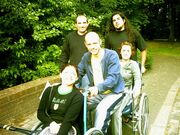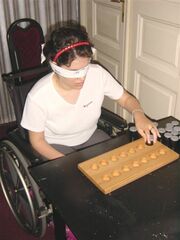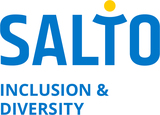Working with people using Wheelchair/Reduced Mobility
- This and a lot more in the SALTO Inclusion for All booklet: No Barriers, No Borders
NOTE: not all wheelchair users are constantly using wheelchairs, some like to change to chairs, some can walk short distances, some like to dance,... Also it is not always visible that someone has a movement restriction (e.g. someone with a heart or respiratory condition might not be able to walk long distances or do very active games). Don't assume, but ask.
Here are some concrete tips, based on the SALTO experiences of various training courses.
It is best to discuss openly with the participants in question how they would feel most comfortable participating in activities. Some would prefer not to participate in methods which comprise a lot of activity, whereas other people like to participate as much as possible, maybe in their own adapted way. It is up to the youth worker (or the participant) to suggest adaptations.
- Foresee more time for moving between areas (breaks, dinners, doing activities outside), give the person with reduced mobility indications beforehand on where the next sessions will be, so that they can start moving on time. Do not move around excessively between areas (get a venue where the working rooms and accommodation are close to each other)
- Place sign-up lists (e.g. for working groups) or flipcharts to write on at a lower level, within reach of people in wheelchairs
- Place the materials within reach (pens, paper, paint, sticky tape,...) and not in inaccessible places (in a box under a table, on the top shelf,...)
- Do activities where people are sitting down or are at the same height (or alternatively where everybody is at a different height anyway). When talking to people in a wheelchair, put yourself at eyelevel for longer conversations or do not lose eye-contact when you are talking standing up.
- Do not lean, step or sit on people's wheelchairs. They are considered by many persons in a wheelchair as part of their body (so they are not the place to hang your shopping bags or coats, put your glass on their desktop or to transport things you don't want to carry - unless they agree).
- Make sure people ask/know how they should behave with the persons using a wheelchair (this can vary). Some want to be pushed (because it is very tiring) others make a point of moving independently.
- Always ask where the person wants to move - instead of just pushing them 'somewhere'. Do offer assistance (e.g. opening the doors, pushing,...) but wait until your offer is accepted.
- When taking hurdles or little steps or moving downhill always go with the big wheels first (backwards), tilting the wheelchair a bit. Ask where you can pull, push or lift the wheelchair (some parts come off easily - so best not to grab those to lift a person)
- People with a mobility disability do not like to be carried like a bag of potatoes. Provide ramps and accessible vehicles where the person can enter using the wheelchair. Lifting people with a physical disability in a wrong way could lead to injuries (for both the person carrying and the one being carried), so if you are likely to be lifting one of your participants, make sure you learn how to.
- If the person using a wheelchair needs to change from the wheelchair to a more comfortable/different seating position (e.g. to prevent aches), you might need to provide comfortable chairs (with arms), or pillows to increase sitting comfort.
- Have chair(s) for people with difficulties walking or standing, when your activity involves long periods of standing. Rent some extra wheelchair(s) or have alternative transportation for long distances. It is best of course to have a solution where the group (or at least part of the group sticks together)
- Foresee alternatives when doing activities with people with hand/body movement restrictions. For example instead of lifting your hand, you could ask everybody to lift their heads - instead of pointing to someone, you could nod or blink. It's good to use this alternative for the whole group in order to not stigmatise the persons with a disability as the odd-ones-out.
- Make sure that passageways are uncluttered. Do not leave material/cables/decoration/sharp objects (thumb tacks, etc) lying around on the floor in spots where people need to step over or pass in a wheelchair.
- Be clear about roles - who is the personal assistant - who helps when and for what (not). The team cannot be a personal assistant, but they can ask some of the participants to help (e.g. with an exercise)
- ...
^^ top ^^
Accessibility guidelines for wheelchairs
When preparing for an international project with one or more people with a wheelchair, you might want to check the following accessibility guidelines (not exhaustive), to see if the venue where you will be staying is adapted for wheelchairs - and to which extent you will have to improvise with make-shift solutions. It is up to you (and the young people, plus their parents) to balance adventure and improvisation with comfort and safety.
Some of the following items are an 'exclusive criteria' (if it is not there a person in a wheelchair could simply not take part- other things can be solved with a bit of creativity and good will.
- Check your venue for all horizontal (from room to room, from outside to inside) and vertical (from floor to ceiling, up and down curbs/steps/streets) moving needs!
- There should be a convenient access (to the work room, the restaurant, the bedrooms, the leisure hang- out places) without any stairs or steps (especially in the case of heavy electric wheelchairs)
- How does the access work - sometimes you will need to press a bell for staff to come and open the accessible entrance, does this function all day long, every day of the week? Are the most accessible routes through a building signposted?
- Ramps should have a gradient of 1/12 (preferably 1/15) and be 120cm wide and on the top and the bottom there should be a horizontal landing of at least 120cm. Make sure ramps are not cluttered.
- Door widths should be at least 85cm and open outwards, with no threshold. Door handles should be lever type (not door knobs) and approximately 104cm high
- How many accessible rooms are there (in case you have more than one wheelchair user)? Most hotels only have one or two. How does the evacuation work in case of fire.
- Bedrooms should have a 120cm free rotating space to at least one side of the bed. All places where a wheelchair needs to turn (around corners, in front of lifts, dining room,...) there should be a turning circle of minimum 150cm.
- Shower should have level access (floor draining) and shower seat. It would be practical to have a showerhead you can take down (and that this one is also down)
- (Public) toilets should have a 85cm door width, opening outwards. There should be a clear floor turning space of 150 x 150cm. The toilet seat should be 45cm high. There should be liftable support rails either side of the wc. Ensure clear space under the wash basin of approx. 70cm high
- Are there accessible toilets near the work rooms and in the dining room/restaurants? To avoid having to go all the way to the accessible bedroom every time to go to the toilet.
- How many lifts are there (if needed) and how many wheelchairs fit in them? Do other participants have reasonably easy alternative ways to get down or up? Lifts tend to be slow and can be a bottleneck causing part of the group to be late for appointments.
- Public telephones should have handsets of no higher than 90cm (even though nowadays most people have mobile phones)
- There is a lower part of the service counter available (reception desk, ticket counters,...) so that the person in a wheelchair can actually see the person behind the counter and vice-versa
- Is there parking space wide enough for a wheelchair to embark and disembark?
You can find many more practical Access for All guidelines on the website of the Maltese National Commission Persons with a Disability www.knpd.org (www.knpd.org/pubs/pdf/accessforall2005.pdf)
In your practical preparation, you will also need to think about the following:
- Insurance for the wheelchair/assistive walking equipment, preferably with on site reparation. Does the country where you are going have the same brand of wheelchairs/equipment? Find and take there contact details.
- Are there parts of the wheelchair/equipment that frequently/easily get damaged? Can you take spare parts? Can you easily repair it yourself?
- If you have an electric wheelchair, can you recharge the battery or do you need to take a spare one. Is the voltage/plugs the same abroad? (e.g. UK, Malta, Ireland have different plugs from mainland Europe)
- Wherever possible locate important functions centrally - try to group rooms used by persons with a disability closer together.
- Is the transport you are going to use accessible? Do you need to arrange it in advance? Plan more time for transport. See also Travelling abroad in mixed-ability groups
^^ top ^^
 Inclusion of ALL
Inclusion of ALL

Downloads
The following downloads are available:
- No Barriers No Borders - international mixed-ability projects - 2008 update
How to set up international projects with young people with and without a disability. With lots of tips & tricks about partnerships, funding, working with disability,... Based on SALTO TC Enable 2003
